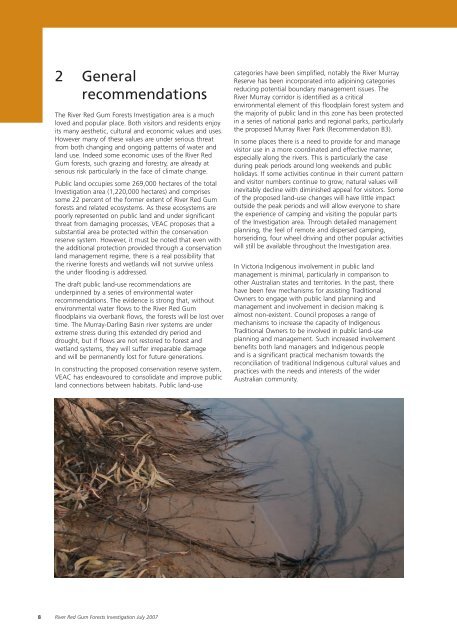Draft Proposals Paper - Full - Victorian Environmental Assessment ...
Draft Proposals Paper - Full - Victorian Environmental Assessment ...
Draft Proposals Paper - Full - Victorian Environmental Assessment ...
Create successful ePaper yourself
Turn your PDF publications into a flip-book with our unique Google optimized e-Paper software.
2 General<br />
recommendations<br />
The River Red Gum Forests Investigation area is a much<br />
loved and popular place. Both visitors and residents enjoy<br />
its many aesthetic, cultural and economic values and uses.<br />
However many of these values are under serious threat<br />
from both changing and ongoing patterns of water and<br />
land use. Indeed some economic uses of the River Red<br />
Gum forests, such grazing and forestry, are already at<br />
serious risk particularly in the face of climate change.<br />
Public land occupies some 269,000 hectares of the total<br />
Investigation area (1,220,000 hectares) and comprises<br />
some 22 percent of the former extent of River Red Gum<br />
forests and related ecosystems. As these ecosystems are<br />
poorly represented on public land and under significant<br />
threat from damaging processes, VEAC proposes that a<br />
substantial area be protected within the conservation<br />
reserve system. However, it must be noted that even with<br />
the additional protection provided through a conservation<br />
land management regime, there is a real possibility that<br />
the riverine forests and wetlands will not survive unless<br />
the under flooding is addressed.<br />
The draft public land-use recommendations are<br />
underpinned by a series of environmental water<br />
recommendations. The evidence is strong that, without<br />
environmental water flows to the River Red Gum<br />
floodplains via overbank flows, the forests will be lost over<br />
time. The Murray-Darling Basin river systems are under<br />
extreme stress during this extended dry period and<br />
drought, but if flows are not restored to forest and<br />
wetland systems, they will suffer irreparable damage<br />
and will be permanently lost for future generations.<br />
In constructing the proposed conservation reserve system,<br />
VEAC has endeavoured to consolidate and improve public<br />
land connections between habitats. Public land-use<br />
categories have been simplified, notably the River Murray<br />
Reserve has been incorporated into adjoining categories<br />
reducing potential boundary management issues. The<br />
River Murray corridor is identified as a critical<br />
environmental element of this floodplain forest system and<br />
the majority of public land in this zone has been protected<br />
in a series of national parks and regional parks, particularly<br />
the proposed Murray River Park (Recommendation B3).<br />
In some places there is a need to provide for and manage<br />
visitor use in a more coordinated and effective manner,<br />
especially along the rivers. This is particularly the case<br />
during peak periods around long weekends and public<br />
holidays. If some activities continue in their current pattern<br />
and visitor numbers continue to grow, natural values will<br />
inevitably decline with diminished appeal for visitors. Some<br />
of the proposed land-use changes will have little impact<br />
outside the peak periods and will allow everyone to share<br />
the experience of camping and visiting the popular parts<br />
of the Investigation area. Through detailed management<br />
planning, the feel of remote and dispersed camping,<br />
horseriding, four wheel driving and other popular activities<br />
will still be available throughout the Investigation area.<br />
In Victoria Indigenous involvement in public land<br />
management is minimal, particularly in comparison to<br />
other Australian states and territories. In the past, there<br />
have been few mechanisms for assisting Traditional<br />
Owners to engage with public land planning and<br />
management and involvement in decision making is<br />
almost non-existent. Council proposes a range of<br />
mechanisms to increase the capacity of Indigenous<br />
Traditional Owners to be involved in public land-use<br />
planning and management. Such increased involvement<br />
benefits both land managers and Indigenous people<br />
and is a significant practical mechanism towards the<br />
reconciliation of traditional Indigenous cultural values and<br />
practices with the needs and interests of the wider<br />
Australian community.<br />
8 River Red Gum Forests Investigation July 2007
















